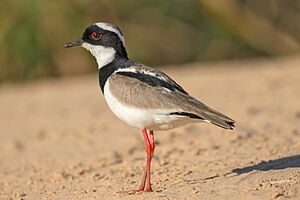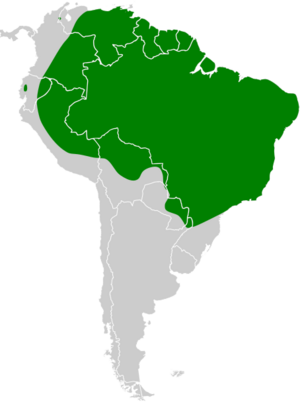Pied plover facts for kids
Quick facts for kids Pied plover |
|
|---|---|
 |
|
| Conservation status | |
| Scientific classification | |
| Genus: |
Hoploxypterus
|
| Species: |
cayanus
|
 |
|
| Synonyms | |
|
|
The pied plover, also called the pied lapwing, is a type of bird. It belongs to the Charadriidae family. It's considered a bird of 'least concern' by the IUCN. This means it's not currently endangered.
You can find the pied plover in northern South America. Its scientific name, cayanus, comes from Cayenne. This is the capital of French Guiana, where these birds live. Even though it's called a 'plover,' scientists now think it's more closely related to birds called lapwings. This is because of how they are grouped in the bird family tree.
Contents
What is a Pied Plover?
The pied plover is part of a group of birds known as shorebirds. These birds often live near water. It belongs to the family called Charadriidae. The pied plover is the only species in its special group, or genus, called Hoploxypterus. This genus was named in 1856 by a French scientist, Charles Lucien Bonaparte.
Scientists used to place the pied plover with other lapwings in the genus Vanellus. However, new studies looking at bird DNA showed it's not as closely related to other lapwings as once thought.
How to Spot a Pied Plover
The pied plover is a striking bird with a clear black and white pattern. Its back and wings have a buff, or light brownish-yellow, color. Its belly is white.
You can easily spot its bright red eye-rings around its eyes. It also has a distinct black 'V' shape on its upper back. Its legs are long and red. This bird is a medium size, like many in its family. It measures about 22 centimeters, which is roughly the length of a ruler.
Males, Females, and Young Birds
Both male and female pied plovers look exactly the same. This is called having no sexual dimorphism. Young pied plovers, called juveniles, look similar to the adults. The main difference is that their buff colors are stronger. Also, their eye-rings are buff instead of bright red.
What Do They Sound Like?
Pied plovers are generally quiet birds. They don't make sounds very often. Their usual call sounds like "kee-oo." The second part of this call is lower in pitch. When they fly during their special display flights, their call changes. It sounds like repeated "klee" sounds.
Where Pied Plovers Live
Pied plovers live along the sandy and muddy shores of lakes and rivers. Their home range covers the northern part of South America. This includes countries like Brazil, Bolivia, Paraguay, Peru, Colombia, Ecuador, Venezuela, Guyana, Suriname, and French Guiana.
Scientists don't know much about how these birds move around. However, it seems they might change their habitat during different times of the year. Some have been seen as high as 2600 meters in Bolivia. This might happen because wet seasons push them to higher ground.
Pied Plover Behavior
Not much is known about the daily behavior of pied plovers. There have been different observations about how they interact with other birds. For example, in Serra da Capivara National Park in Brazil, they were seen flocking only with other pied plovers. They did not mix with other shorebirds.
However, in Tambopata Reserve in Peru, pied plovers were seen alone or in pairs. They were not flocking together there. This shows their behavior might change depending on the location.
What Pied Plovers Eat
Scientists are still learning about what pied plovers eat. They mainly feed on insects and snails. They have also been seen holding a crustacean with their bill. It's not clear if they eat crustaceans often. One interesting thing they eat is scorpions, which has been recorded in Brazil.
Reproduction and Life Cycle
Pied plovers have special ways of showing off to find a mate. Their displays involve flying in the air in a wavy pattern while calling out. On the ground, they might stand facing each other with their wings spread wide.
Generally, pied plovers mate between May and July. They usually lay their eggs in July. However, these times can be different depending on the region.
Pied plovers build their nests on the ground. They dig a shallow hole for their nest. The nest is not lined with soft materials. This means their eggs rest directly on the ground. When they leave the nest, they cover their eggs with sand. This helps to protect them from danger.
Images for kids




